
A reef is a ridge or shoal of rock, coral, or similar relatively stable material lying beneath the surface of a natural body of water. Many reefs result from natural, abiotic (non-living) processes such as deposition of sand or wave erosion planing down rock outcrops. However, reefs such as the coral reefs of tropical waters are formed by biotic (living) processes, dominated by corals and coralline algae. Artificial reefs, such as shipwrecks and other man-made underwater structures, may occur intentionally or as the result of an accident. These are sometimes designed to increase the physical complexity of featureless sand bottoms to attract a more diverse range of organisms. Reefs are often quite near to the surface, but not all definitions require this.

Anthozoa is a class of marine invertebrates which includes the sea anemones, stony corals and soft corals. Adult anthozoans are almost all attached to the seabed, while their larvae can disperse as part of the plankton. The basic unit of the adult is the polyp; this consists of a cylindrical column topped by a disc with a central mouth surrounded by tentacles. Sea anemones are mostly solitary, but the majority of corals are colonial, being formed by the budding of new polyps from an original, founding individual. Colonies are strengthened by calcium carbonate and other materials and take various massive, plate-like, bushy or leafy forms.
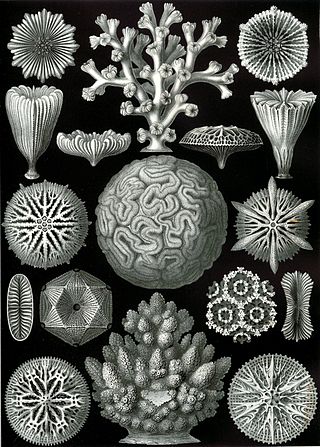
Scleractinia, also called stony corals or hard corals, are marine animals in the phylum Cnidaria that build themselves a hard skeleton. The individual animals are known as polyps and have a cylindrical body crowned by an oral disc in which a mouth is fringed with tentacles. Although some species are solitary, most are colonial. The founding polyp settles and starts to secrete calcium carbonate to protect its soft body. Solitary corals can be as much as 25 cm (10 in) across but in colonial species the polyps are usually only a few millimetres in diameter. These polyps reproduce asexually by budding, but remain attached to each other, forming a multi-polyp colony of clones with a common skeleton, which may be up to several metres in diameter or height according to species.
Bushy Island is a vegetated coral cay in Queensland, Australia in the Great Barrier Reef Marine Park Queensland, Australia. It is about 70 km east of Mackay. There are no other vegetated cays in the more than 600 km stretch between Bushy Island and Green Island. The coral species Acropora bushyensis, one of many species in the genus Acropora, is most heavily concentrated in Bushy Island lagoon, existing only rarely elsewhere in the eastern portion of the Great Barrier Reef and not at all in the western portion. The island is an accumulation of biogenic sediment similar to Heron Island, and it has been sufficiently stable to accumulate vegetation. A major component of the mobile sands of Bushy Island is Foraminifera, a type of amoeboid protist. Foraminiferan sands are more easily eroded off of the cay. Bushy Island is located inside the zero isobase on an elevated reef flat, onto which the cay often erodes.
Sir Charles Maurice Yonge, CBE, FRS FRSE was an English marine zoologist.
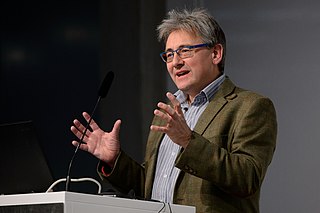
Callum Michael Roberts is a British marine conservation biologist, oceanographer, science communicator, author and research scholar at the University of Exeter. He was formerly at the University of York. He is best known for his research and advocacy related to marine reserves and the environmental impact of fishing.

Montipora is a genus of Scleractinian corals in the phylum Cnidaria. Members of the genus Montipora may exhibit many different growth morphologies. With eighty five known species, Montipora is the second most species rich coral genus after Acropora.

The Coral Triangle (CT) is a roughly triangular area in the tropical waters around the Philippines, Indonesia, Malaysia, Papua New Guinea, the Solomon Islands and Timor-Leste. This area contains at least 500 species of reef-building corals in each ecoregion. The Coral Triangle is located between the Pacific and Indian oceans and encompasses portions of two biogeographic regions: the Indonesian-Philippines Region, and the Far Southwestern Pacific Region. As one of eight major coral reef zones in the world, the Coral Triangle is recognized as a global centre of marine biodiversity and a global priority for conservation. Its biological resources make it a global hotspot of marine biodiversity. Known as the "Amazon of the seas", it covers 5.7 million square kilometres (2,200,000 sq mi) of ocean waters. It contains more than 76% of the world's shallow-water reef-building coral species, 37% of its reef fish species, 50% of its razor clam species, six out of seven of the world's sea turtle species, and the world's largest mangrove forest. In 2014, the Asian Development Bank (ADB) reported that the gross domestic product of the marine ecosystem in the Coral Triangle is roughly $1.2 trillion per year and provides food to over 120 million people. According to the Coral Triangle Knowledge Network, the region annually brings in about $3 billion in foreign exchange income from fisheries exports, and another $3 billion from coastal tourism revenues.

Pocillopora is a genus of stony corals in the family Pocilloporidae occurring in the Pacific and Indian Oceans. They are commonly called cauliflower corals and brush corals.
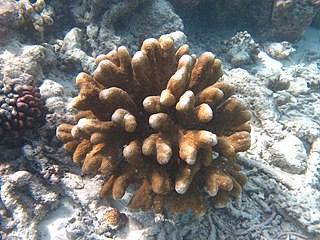
Isopora palifera is a species of stony coral in the family Acroporidae. It is a reef building coral living in shallow water and adopts different forms depending on the water conditions where it is situated. It is found in the Western Indo-Pacific Ocean as far east as Australia.

Euphyllia ancora is a species of hard coral in the family Euphylliidae. It is known by several common names, including anchor coral and hammer coral, or less frequently as sausage coral, ridge coral, or bubble honeycomb coral.

Catalaphyllia is a monotypic genus of stony coral in the family Euphylliidae from the western Pacific Ocean. It is represented by a single species, Catalaphyllia jardinei, commonly known as elegance coral. It was first described by William Saville-Kent in 1893 as Pectinia jardinei.

Acropora aculeus is a species of acroporid corals found throughout the Indian Ocean, the central Indo-Pacific, Australia, southeast Asia, Japan and the East China Sea. It is also present in the western Pacific Ocean. It is an uncommon species and is particularly prone to coral bleaching, disease, and crown-of-thorns starfish predation; it is also harvested for use in aquaria, and the International Union for Conservation of Nature has assessed it as being a "vulnerable species". Habitat loss is a big concern.
Carden Crea Wallace is an Australian scientist who was the curator/director of the Museum of Tropical Queensland from 1987 to 2003. She is an expert on corals having written a "revision of the Genus Acropora". Wallace was part of a team that discovered mass spawning of coral in 1984.
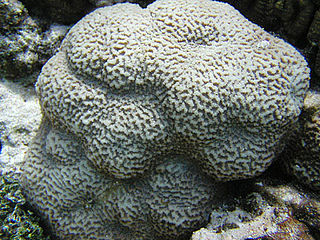
Platygyra contorta is a species of colonial stony coral in the family Merulinidae. It was described by John Veron in 1990. It is found at depths of 2 to 20 metres and its colonies are over 1 metre (3.3 ft) in diameter. It has been identified as a least-concern species.
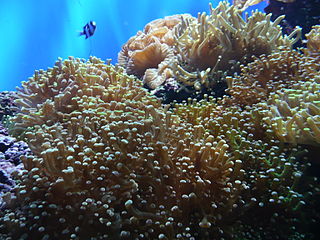
Euphylliidae are known as a family of polyped stony corals under the order Scleractinia.

Pocillopora capitata, commonly known as the Cauliflower coral, is a principal hermatypic coral found in the Eastern Tropical Pacific. P. capitata is a colonial species of stony coral of the class Anthozoa, the order Scleractinia, and the family Pocilloporidae. This species was first documented and described by Addison Emery Verrill in 1864. P. capitata is threatened by many of the effects of climate change, including — but not limited to — increased temperatures that cause bleaching and hypoxic conditions.

Leptastrea is a genus of massive reef building stony corals known primarily from the Indo-Pacific. Although previously assigned to Faviidae, Budd et al. (2012) assigned it to Scleractinia incertae sedis based on phylogenetic results demonstrating the polyphyly of Faviidae. Assigned to family Leptastreidae by Rowlett (2020).
The Museum of Underwater Art (MOUA) is a series of underwater art installations near Townsville, Australia. The museum aims to promote the conservation of the Great Barrier Reef while acting as a public snorkelling and scuba diving attraction. It is the only underwater art museum in the Southern Hemisphere and consists of three sculptures created by British sculptor Jason deCaires Taylor. The museum opened in 2020.
Peter L. Harrison is an Australian marine biologist, ecologist, and a Distinguished Professor at Southern Cross University, Australia, and the founding director of the Marine Ecology Research Centre. His specialty is coral reproduction ecology and larval restoration.















